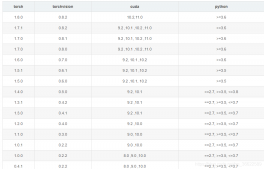自定义比较排序/运算符
Python3和Python2相比有挺多变化。
在Python2中可以直接写一个cmp函数作为参数传入sort来自定义排序,但是Python3取消了。
在这里总结一下Python3的自定义排序的两种写法,欢迎补充。
我们以二维空间中的点来作为待排序的数据结构,我们希望能先比较x后再比较y。
|
1
2
3
4
5
6
7
8
9
|
class Pos: def __init__(self, x = 0, y = 0): self.x = x self.y = y def __str__(self): return ('(%s, %s)' % (self.x, self.y)) __repr__ = __str__ |
1.cmp函数
第一种方法我们还是以重写cmp或lambda表达式的形式,和Python2很类似
注意,此方法用sorted是不能成功排序的
只是要借助functools
|
1
2
3
4
5
6
7
8
9
10
11
|
import functoolsdef cmp(a, b): return a.x-b.x if a.x != b.x else a.y-b.y # x y均按照从小到大的顺序 if __name__ == '__main__': test_list = [Pos(5, 1), Pos(2,5), Pos(2, 4)] # test_list.sort(key=functools.cmp_to_key(lambda a,b: a.x-b.x if a.x != b.x else a.y-b.y)) test_list.sort(key=functools.cmp_to_key(cmp)) # sorted(test_list, key=functools.cmp_to_key(cmp)) # 亲测此方法不能成功排序 print(test_list) # 输出结果 [(2, 4), (2, 5), (5, 1)] |
2.重写类方法
Python2中可以直接重写__cmp__方法来实现比较,但是Python3中已经取消了.
Python3中需要细分每一个比较运算符.
|
1
2
3
4
5
|
__lt__: <__gt__: >__ge__: >=__eq__: ==__le__: <= |
实现如下
|
1
2
3
4
5
6
7
8
9
10
11
12
13
14
15
16
17
18
19
20
21
22
23
24
25
26
27
28
29
|
class Pos: def __init__(self, x = 0, y = 0): self.x = x self.y = y def __str__(self): return ('(%s, %s)' % (self.x, self.y)) def __lt__(self, other): print('lt: ' + str(self)) return self.x < other.x if self.x != other.x else self.y < other.y def __gt__(self, other): print('gt: ' + str(self)) return self.x > other.x if self.x != other.x else self.y > other.y def __ge__(self, other): print('ge: ' + str(self)) return self.x >= other.x if self.x != other.x else self.y >= other.y def __eq__(self, other): print('eq: ' + str(self)) return self.x == other.x and self.y == other.y def __le__(self, other): print('le: ' + str(self)) return self.x <= other.x if self.x != other.x else self.y <= other.y __repr__ = __str__ |
我们实践一下
|
1
2
3
4
5
6
7
8
9
10
11
12
13
|
if __name__ == '__main__': if Pos(5,1) <= Pos(2,4): print('True!') if Pos(5,1) == Pos(2,4): print('True!') if Pos(5,1) > Pos(2,4): print('True!')# 输出# le: (5, 1)# eq: (5, 1)# gt: (5, 1)# True! |
最后我们回到排序
|
1
2
3
4
5
6
7
8
9
10
11
12
13
14
15
16
|
if __name__ == '__main__': test_list = [Pos(5, 1), Pos(2,5), Pos(2, 4)] test_list.sort() print(test_list) test_list.sort(reverse=True) print(test_list) # 输出# lt: (2, 5)# lt: (2, 4)# [(2, 4), (2, 5), (5, 1)]# lt: (2, 5)# lt: (2, 4)# [(5, 1), (2, 5), (2, 4)] |
Python3实现各种排序方法
|
1
2
3
4
5
6
7
8
9
10
11
12
13
14
15
16
17
18
19
20
21
22
23
24
25
26
27
28
29
30
31
32
33
34
35
36
37
38
39
40
41
42
43
44
45
46
47
48
49
50
51
52
53
54
55
56
57
58
59
60
61
62
63
64
65
66
67
68
69
70
71
72
73
74
75
76
77
78
79
80
81
82
83
84
85
86
87
88
89
90
91
92
93
94
95
96
97
98
99
100
101
102
103
104
105
106
107
108
109
110
111
112
113
114
|
# coding=gbkimport randomfrom array import arraydef swap(lyst,i,j): temp = lyst[i] lyst[i] = lyst[j] lyst[j] = temp#选择排序,复杂度O(n^2)def selectionSort(lyst): i = 0 while i < len(lyst) - 1: minIndex = i j = i + 1 while j < len(lyst): if lyst[j] < lyst[minIndex]: minIndex = j j += 1 if minIndex != i: swap(lyst,minIndex,i) i += 1#冒泡排序,复杂的O(n^2)def bubbleSort(lyst): n = len(lyst) while n > 1: i = 1 while i < n: if lyst[i] < lyst[i-1]: swap(lyst,i,i-1) i += 1 n -= 1#冒泡排序优化改进最好情况def bubbleSortWithTweak(lyst): n = len(lyst) while n > 1: swapped = False i = 1 while i < n: if lyst[i] < lyst[i-1]: swap(lyst,i,i-1) swapped = True i += 1 if not swapped: return n -= 1#插入排序,复杂的O(n^2)def insertionSort(lyst): i = 1 while i < len(lyst): itemToInsert = lyst[i] j = i - 1 while j >= 0: if itemToInsert < lyst[j]: lyst[j+1] = lyst[j] j -= 1 else: break lyst[j+1] = itemToInsert i += 1#快速排序,最好情况,复杂的O(n*(log2 n)),最坏情况,复杂的O(n^2)def quicksort(lyst): quicksortHelper(lyst,0,len(lyst)-1)def quicksortHelper(lyst,left,right): if left < right: pivotLocation = partition(lyst,left,right) quicksortHelper(lyst,left,pivotLocation-1) quicksortHelper(lyst,pivotLocation+1,right)def partition(lyst,left,right): middle = (left+right) // 2 pivot = lyst[middle] lyst[middle] = lyst[right] lyst[right] = pivot boundary = left for index in range(left,right): if lyst[index] < pivot: swap(lyst,index,boundary) boundary += 1 swap(lyst,right,boundary) return boundary#合并排序def mergeSort(lyst): copyBuffer = [0]*(len(lyst)) mergeSortHelper(lyst,copyBuffer,0,len(lyst)-1)def mergeSortHelper(lyst,copyBuffer,low,high): if low < high: middle = (low+high)//2 mergeSortHelper(lyst,copyBuffer,low,middle) mergeSortHelper(lyst,copyBuffer,middle+1,high) merge(lyst,copyBuffer,low,middle,high)def merge(lyst,copyBuffer,low,middle,high): i1 = low i2 = middle + 1 for i in range(low,high+1): if i1 > middle: copyBuffer[i] = lyst[i2] i2 += 1 elif i2 > high: copyBuffer[i] = lyst[i1] i1 += 1 elif lyst[i1] < lyst[i2]: copyBuffer[i] = lyst[i1] i1 += 1 else : copyBuffer[i] = lyst[i2] i2 += 1 for i in range(low,high+1): lyst[i] = copyBuffer[i]def main(size = 20,sort = mergeSort): lyst = [] for count in range(size): lyst.append(random.randint(1,size+1)) print(lyst) sort(lyst) print(lyst)if __name__ == "__main__": main() |
以上为个人经验,希望能给大家一个参考,也希望大家多多支持服务器之家。
原文链接:https://blog.csdn.net/as1171799253/article/details/83685615












